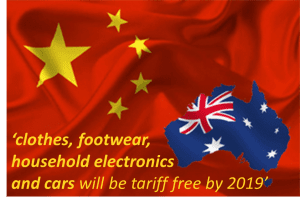 The China-Australia Free Trade Agreement (ChAFTA) was signed in Canberra on 17 June 2015.
The China-Australia Free Trade Agreement (ChAFTA) was signed in Canberra on 17 June 2015.
One more step in the process, but it will still take time for ChAFTA to come into force.
Here are the key points for Australian importers.
Parliamentary Process
The Agreement still needs to be accepted by the parliaments of both countries.
In Australia, the process began the day the Agreement was signed. Trade and Investment Minister Andrew Robb tabled the Agreement in the Australian Parliament.
JSCOT
The Joint Standing Committee on Treaties (JSCOT) is now conducting an inquiry into the Agreement. This is standard procedure. It will report back to Parliament, usually within 20 joint sitting days. Parliament then reviews the report and makes amendments to relevant legislation and Regulations. The timeline for this stage is not fixed.
After this, Australia is ready to exchange diplomatic notes. This will confirm it is ready for the Agreement to come into force.
Senate Inquiry
The Australian Senate Reference Committee on Foreign Affairs, Defence and Trade is conducting its own inquiry. This is independent of JSCOT, with different terms of reference. Submissions close on 28 August. This inquiry will report within 1 month of JSCOT.
Chinese Ratification
In China, the government is following its own treaty-making process. This involves submission to the State Council, then referral to the Standing Committee of the National People’s Congress for final ratification.
Diplomatic notes will be exchanged once both countries have completed their domestic processes.
Implementation
The China Australia Free Trade Agreement will come into force 30 days after the diplomatic notes, unless another period is agreed on.
If all goes well, the Agreement should come into force towards the end of 2015.
But will all go well? The FTA includes Investor State Dispute Settlement (ISDS). Australia is already being sued by foreign tobacco companies under a similar clause in a different treaty. The Productivity Commission says the FTA is ‘dangerous.’ And voters are worried about cheap Chinese labour in Australia. Delays are certainly possible.
Import Tariff Reductions
There is one key impact of the China Australia Free Trade Agreement for importers. That’s the reduction (phase-out) of import tariffs for Chinese goods.
This includes the 5% tariff on Chinese manufacturing exports, electronics and white goods, which will gradually reduce to zero. There are usually 3 or 5 stages of tariff reduction. More details are in the Schedule for Australia and associated listing by Harmonised System Code.
Note that staged tariff reductions occur on 1 January each year, not on the anniversary of implementation. So juggling stock levels to bring in the bare minimum before Christmas could save you money. Just make sure you don’t leave customers unsupplied!
Ensuring your Imports Qualify for ChAFTA Treatment
If you want goods imported into Australia to qualify for ChAFTA, you will need the right documentation. That will be a Certificate of Origin (COO) or a Declaration of Origin (DOO). Either must be issued by an authorised body in China.
It’s not yet known what those bodies will be.
You will need documents for each individual shipment. There’s more detail in this DFAT document.
***
There are no immediate changes for importers, But it’s time to review your options. In a previous post about ChAFTA, we quoted David Morfesi, Executive Director of the Institute for International Trade at the University of Adelaide.
Reducing the costs of imports from China is likely to be as important to small businesses as encouraging more exports to China.
If you source locally, lower import tariffs may make sourcing from China more attractive. But this could increase your leadtimes, especially for first shipments where you need to find a quality supplier. Hornet recommend starting early. That way you have time for any problems which arise.
If you normally order large production runs in China, don’t import too much too soon. Consider using a warehouse in China to store excess stock until import tariffs decrease.
Y
***
To keep up to date with the Australia China Free Trade Agreement, consult the DFAT site.
